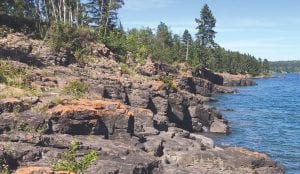In Lake County where two-acre lots along Lake Superior are common, Karl and Beth Johansson decided to protect one of the last large lakeshore parcels that remain in private ownership.
Over the last decade, the Johanssons acquired several small lots with the idea of amassing a larger parcel that would not only provide better wildlife habitat but would also decrease the impact of humans on this fragile landscape.
The result? Karl and Beth protected 65 acres and close to a half mile of bedrock shoreline that’s visible from the Lake Superior Water Trail and the North Shore Scenic Railroad.
Protecting this land and its fragile shoreline supports the habitat of familiar species such as bald eagle, lake sturgeon, and Canada lynx. It also preserves the damp, barren arctic like conditions that support the rare Hudson Bay eyebright.
“This plant is called an ‘arctic-alpine disjunct,’” according to Project Manager Pat Collins, “which means that this plant is normally found in arctic or alpine conditions. Biologists believe it’s a relic from a previous Ice Age that’s able to flourish here because of the unique habitat conditions of Minnesota’s North Shore.”
Some parts of the land’s forest habitat features were lost to historic logging and other uses. Recently, however, the owners have started planting cedars, white pines, white spruces, and native grasses – species that do not readily come back on their own.
In addition to the scenic value and rare plant habitat, the property is in an important flyway for raptors and songbirds. The U.S. Fish and Wildlife Service identified the migration corridor “as likely the most important in the state of Minnesota for over 200 species of migratory birds.”
This permanent conservation easement was made possible thanks to the members of the Minnesota Land Trust and the Outdoor Heritage Fund as recommended by the Lessard-Sams Outdoor Heritage Council.
For more information regarding the Minnesota Land Trust’s Critical Shoreland Protection Program, contact Pat Collins at 218-336-2031.
The Minnesota Land Trust is a membership-based nonprofit organization. Its mission is to protect and restore Minnesota’s most vital natural lands in order to provide wildlife habitat, clean water, outdoor experiences, and scenic beauty for generations to come. The organization has completed 518 conservation projects statewide, permanently protecting over 50,000 acres of natural and scenic land and over a million feet of fragile shoreline.
A conservation easement is a voluntary, legal agreement between a landowner and a land trust or other qualified agency that permanently limits certain uses of land in order to protect its conservation values. Landowners continue to own and enjoy the land and pay property taxes. Once created, the conservation easement is binding on all future owners of the property. More information can be found at www.mnland.org.



Loading Comments